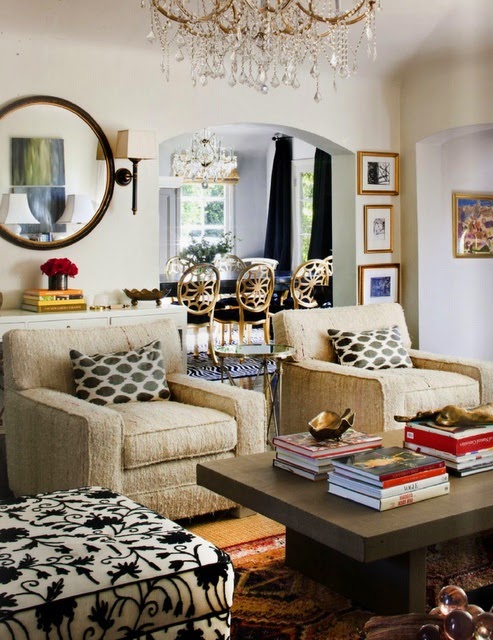F for focal point
There are two strong focal points in this room (below) - tall windows either side of the small artwork mark the centre where the eye is encouraged to rest. This is accentuated by the furniture arrangement. Additionally, the chimney breast wall with the fireplace and mirror above create an obvious focal point...
When deciding on the main focal point for a room consider that it will set the tone and mood for that space.
Art - Position art centrally in a symmetrical or asymmetrical layout. Art can become the main colour influence in a room and, if selected wisely, will instantly draw the eye to it. Make sure art doesn’t clash with its surroundings and that the backdrop wall does not compete with it. Use a series of prints or artworks or one bold, large piece to act as a feature.
Even behind the armchairs (below) the round black-framed mirror draws the eye towards it…
Texture and pattern can create striking focal points. Use these on walls to give a space depth, style and character and show off the areas to be highlighted. Contrast textures to achieve the maximum effect. For example, a smooth, shiny surface beside a heavily textured stone wall.
Don’t forget lighting - crucial to add drama to an interior design and to highlight ornaments, walls, or different zones. Lighting is fantastic at changing mood and a focal point created in the evening can be completely different during the day. This flexibility means the interior design can remain dynamic and interesting.
Every room should have at least one focal point. A main focal point is the one thing that draws the eye immediately upon entering a room. Hopefully this will be something tasteful and stylish – not a humungous heap of crumpled laundry thrown over a clothes airer! If there is not an obvious focal point, such as a fireplace within the room, then an oversized piece of art, a large artefact, or even a beautiful pair of curtains framing a window – preferably with a stunning view beyond - work well. The focal point should never be the television! Architectural features can become amazing focal points but they can also be created with texture, lighting fixtures and other accessories.
The black paint and symmetrical furniture arrangement in this room draw your eye immediately to the fireplace wall. Multiple focal points include the creative coffee table display…
There are two strong focal points in this room (below) - tall windows either side of the small artwork mark the centre where the eye is encouraged to rest. This is accentuated by the furniture arrangement. Additionally, the chimney breast wall with the fireplace and mirror above create an obvious focal point...
When deciding on the main focal point for a room consider that it will set the tone and mood for that space.
Art - Position art centrally in a symmetrical or asymmetrical layout. Art can become the main colour influence in a room and, if selected wisely, will instantly draw the eye to it. Make sure art doesn’t clash with its surroundings and that the backdrop wall does not compete with it. Use a series of prints or artworks or one bold, large piece to act as a feature.
Even behind the armchairs (below) the round black-framed mirror draws the eye towards it…
Colour can be used to draw attention to certain elements within an interior design. Architectural elements, alcoves, walls, doors or fireplaces can be painted in a strong colour to draw the eye to them and this trick can also be applied to items of furniture or rugs.
Texture and pattern can create striking focal points. Use these on walls to give a space depth, style and character and show off the areas to be highlighted. Contrast textures to achieve the maximum effect. For example, a smooth, shiny surface beside a heavily textured stone wall.
Don’t forget lighting - crucial to add drama to an interior design and to highlight ornaments, walls, or different zones. Lighting is fantastic at changing mood and a focal point created in the evening can be completely different during the day. This flexibility means the interior design can remain dynamic and interesting.
 |
| Photo: europaconcorsi |




